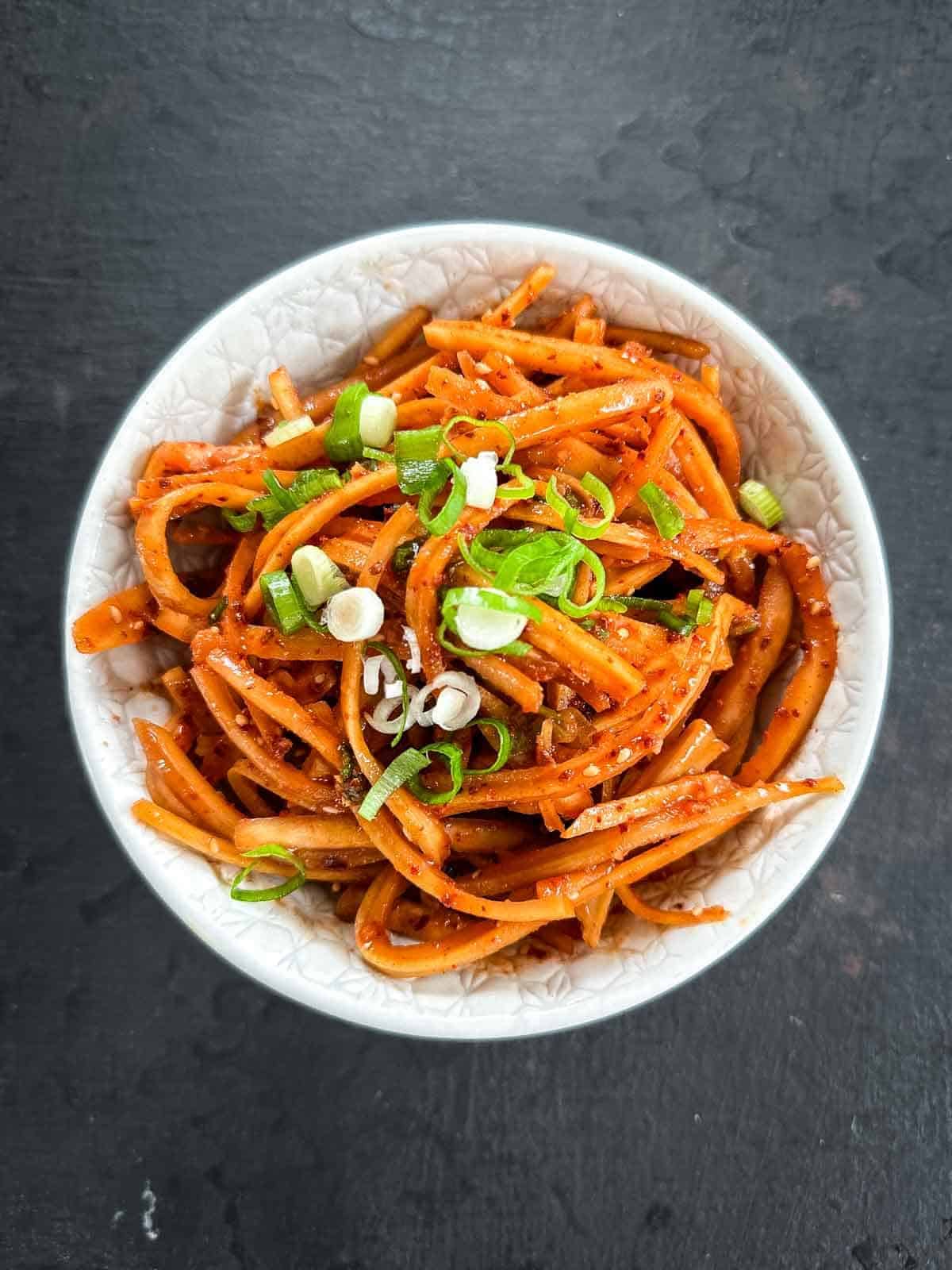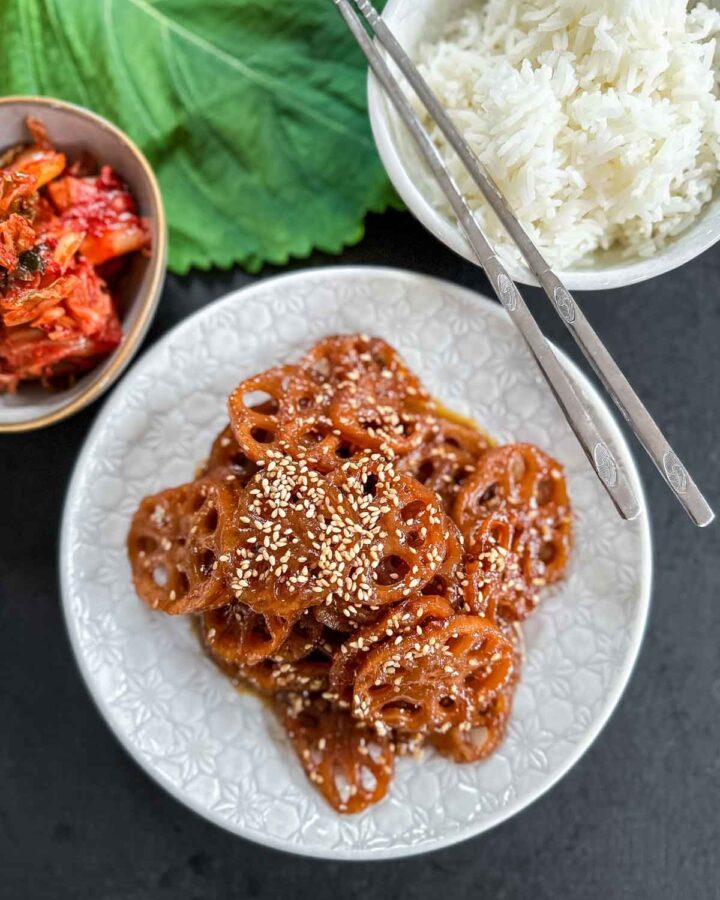Doraji Muchim is calling your name! This Korean side dish bursts with flavour, featuring crunchy bellflower root, tangy vinegar, and a fiery kick.
Jump to:
- Why You’ll Love Korean Bellflower Root Side Dish
- What Is Bellflower Root?
- What Does Bellflower Root Taste Like?
- Korean Bellflower Root Where to Buy?
- Recipe Overview
- Ingredients
- Variations and Substitutions
- Instructions
- How to Make This Side Dish Perfectly [Expert Tips!]
- What To Serve with This Side Dish
- Frequently Asked Questions
- Recipe
Why You’ll Love Korean Bellflower Root Side Dish
Nothing more daunting than making a new recipe with new ingredients for the first time. Whilst those of us who love Korean food have probably tried Korean bellflower root before, you’ve probably never tried making this side dish.
Well, let me tell you that it is beyond easy.
All you have to do is identify the bellflower root in the first instance, in its dried form. See picture below. Then all you’re doing is soaking them overnight to soften them.
You then treat it as you would any other vegetable, and in this case, it is eaten as it is. No further cooking is required to enjoy doraji muchim.
Love the textural contrast and flavours that pack a punch. Like many Korean banchan, so good to have with steaming hot rice, accompanied by all our other favourites such as Korean braised potatoes – gamja jorim and Korean steamed eggplant side dish – gaji namul.
What Is Bellflower Root?
Bellflower root, also known as doraji in Korean, is a versatile ingredient extracted from the Platycodon grandiflorum plant. Its popularity extends beyond cuisine, finding application in traditional medicine as well.
For centuries, bellflower root has held a prominent place in traditional Chinese medicine. That is because it is believed to have anti-inflammatory, anti-allergic, and expectorant properties, making it a potential tool for managing coughs, colds, and sore throats.

What Does Bellflower Root Taste Like?
Fresh bellflower root possesses a slightly bitter and nutty flavour. When cooked properly, the bitterness mellows, leaving a hint of sweetness and a satisfying crunch.
This unique taste profile makes it a common addition to Korean dishes, where it frequently features in stir-fries, pickles, and even soups and stews.
Korean Bellflower Root Where to Buy?
Dried bellflower root is easily available in Korean supermarkets. They can be found in the fresh vegetable section and, in most cases, come pre-packed.
Recipe Overview
Flavour/Texture: Doraji muchim is a delightful dance of flavours and textures. The sweetness and tang are balanced by the spice, while the crunchy root contrasts perfectly with the soft scallions and silky sauce.
Ease: Super easy to make as there are no cooking elements to this recipe. Just some soaking, chopping, and tossing.
Time: Apart from the overnight soak, this recipe will only take you about 10 minutes to put together.
Ingredients
These are the ingredients you need for Korean bellflower root side dish:

Dried bellflower root: If you’re not able to get dried bellflowers in smaller denominations than 100g or about 4 oz, you can certainly make more. This Korean bellflower root side dish can last up to 4 weeks in the fridge. It won’t go to waste!
Gochujang and gochugaru: The 2 most important Gs in the Korean culinary repertoire! This is a double whammy of heat and spice.
Rice syrup and sugar: Adding sweetness to the recipe helps to balance out the bitterness from the bellflower root and tame the spiciness. The rice syrup is important as it helps to thicken the sauce and makes it stick to the bellflower roots.
Rice wine vinegar: The vinegar is yet another ingredient to balance out the flavours. The added tang helps to cut through the sweetness.
Soy sauce: Umami saltiness. Can’t go wrong!
Garlic: Quintessential ingredient in Korean banchan dishes. Make sure it is nice and fresh.
Scallions: Add a generous amount to give the banchan some much-needed greens.
Sesame oil: Love the aromatic addition of Korean sesame oil. Truly gives the recipe a lift.
Sesame seeds: Added nuttiness to the dish.
Variations and Substitutions
Heat levels: the amount of gochujang required for this side dish is important. We need the paste to bind all the ingredients together. If you wish to dial the heat up or down, adjust the gochugaru.
Rice syrup substitute: If you don’t have rice syrup, you can use corn syrup. You just need the sticky, sweet consistency to work with all the other ingredients. You can also use this in our Korean dried pollock with gochujang side dish.
Rice wine vinegar replacement: Apple cider vinegar is a good alternative. Just requires the acidity and tang to cut through the flavours.
Gluten free recipe: Replace soy sauce with tamari and ensure that the gochujang is made from glutinous rice and not barley malt.
Instructions
Step by step instructions for how to make Korean bellflower root side dish:
Place dried bellflower root into a bowl, add water and cover with cling film. Soak overnight in the refrigerator. Drain, pat dry and set aside.


In a large mixing bowl, add gochujang, gochugaru, rice syrup, rice wine vinegar, soy sauce, sugar, garlic, salt, and scallions. Mix until well combined.


Add Korean bellflower root and toss until well coated.

Add sesame oil and sesame seeds and toss until well coated.
Serve.
How to Make This Side Dish Perfectly [Expert Tips!]
Overnight soak: Soak for a good 12 hours at a minimum to really reconstitute the dried bellflower roots. It naturally has a crunchy texture, but you don’t want it to be chewy because it is still a little dry.
Pat dry: After draining the bellflower roots, ensure they are nice and dry before adding to the sauce mixture. You don’t want this Korean side dish to be wet and soggy.
Gochujang and rice malt syrup: These 2 ingredients are essential for the success of this recipe. The sticky, silky sauce attaches itself right across the bellflower roots and gives it the much-needed flavours.
What To Serve with This Side Dish
What to serve with Korean bellflower root side dish? Try these delicious main dish recipes:
This bellflower root banchan can go with so many different Korean dishes. If you would like to try a different type of rice, this Korean purple rice recipe will knock your socks off!
For something a little bit more substantial, try this Kalbi (galbi) korean bbq short ribs and add this mild & creamy rose tteokbokki as another side dish or appetiser.
Frequently Asked Questions
If placed in an airtight container in the refrigerator, it can last for up to 4 weeks.
While bellflower root and ginseng are often mentioned together due to their similar appearances and used in Asian cuisine and traditional medicine, they are not the same plant or root.
Bellflower roots are long, tapered roots with a light beige colour and smooth texture, while ginseng has thicker, forked roots with a light brown to yellowish-white colour and wrinkled texture.
Korean cuisine heavily utilises bellflower root, incorporating it into various dishes to enhance flavour and texture. Popular in stir fries, bellflower roots can be sauteed with garlic and ginger and complemented with other sauces.
Another popular way to eat bellflower roots is to add chunks of doraji to soups and stews for a subtle sweetness and textural contrast, as well as to make savoury pancakes with dipping sauces.
This is such a fantastic side dish to impress your Korean friends and adding to our repertoire of Korean side dish recipes! The flavours and textures are warm, fiery and dynamic. Yet another Korean side dish you won’t be able to stop eating once you start. Bring on that Korean BBQ!
That’s all!
More Korean Side Dishes:

Recipe
Korean Bellflower Root Side Dish – Doraji Muchim [도라지무침]
Ingredients
- 100 g dried bellflower root
- 4 tbsp gochujang
- 3 tbsp gochugaru
- 2 tbsp rice syrup
- 3 tbsp rice wine vinegar
- 1 tbsp soy sauce
- 1 tbsp sugar
- 2 garlic clove, minced
- salt, to taste
- 2 sprig scallion, chopped
- 2 tsp sesame oil
- 2 tsp sesame seeds
Click on the toggle below for conversion to US Cooking Units.
Instructions
- Place dried bellflower root into a bowl, add water and cover with cling film. Soak overnight in the refrigerator. Drain, pat dry and set aside.
- In a large mixing bowl, add gochujang, gochugaru, rice syrup, rice wine vinegar, soy sauce, sugar, garlic, salt, and scallions. Mix until well combined.
- Add Korean bellflower root and toss until well coated.
- Add sesame oil and sesame seeds and toss until well coated.
- Serve.
Notes
- The amount of gochujang required for this side dish is important. We need the paste to bind all the ingredients together. If you wish to dial the heat up or down, adjust the gochugaru.
- If you don’t have rice syrup you can use corn syrup. You just need the sticky sweet consistency to work with all the other ingredients.
- Apple cider vinegar is a good alternative for rice wine vinegar. Just requires the acidity and tang to cut through the flavours.
- For a gluten free recipe, replace soy sauce with tamari and ensure that the gochujang is made from glutinous rice and not barley malt.
- Soak for a good 12 hours at a minimum to really reconstitute the dried bellflower roots. It naturally has a crunchy texture, but you don’t want it to be chewy because it is still a little dry.
- After draining the bellflower roots, ensure they are nice and dry before adding to the sauce mixture. You don’t want this Korean side dish to be wet and soggy.
- Gochujang and rice malt syrup are 2 ingredients that are essential for the success of this recipe. The sticky, silky sauce attaches itself right across the bellflower roots and gives it the much-needed flavours.
Nutrition
*Disclaimer: Nutritional information provided is an estimate only and generated by an online calculator.
Follow us on Facebook, Pinterest, Instagram and Twitter for the latest updates!
Disclaimer: This site contains affiliate links to products. We may receive a commission for purchases made through these links at no additional cost to you.




















Leave a Review